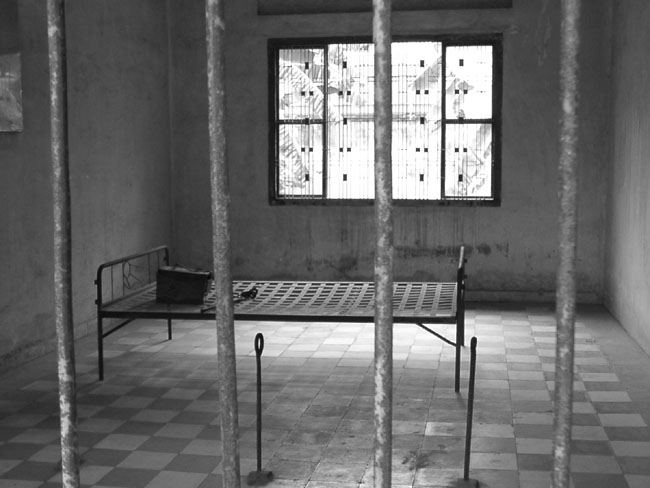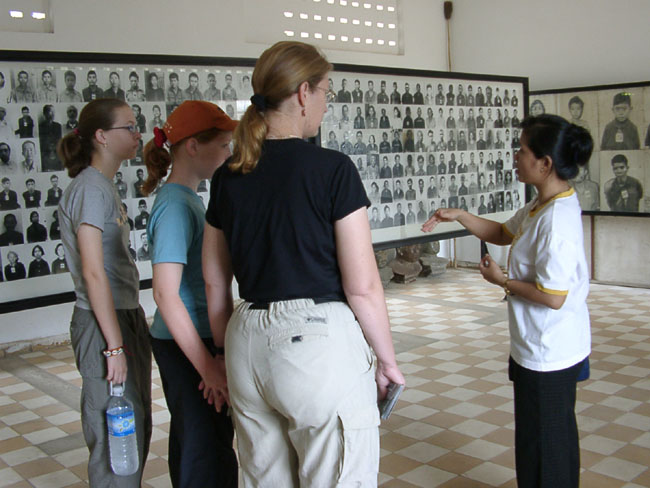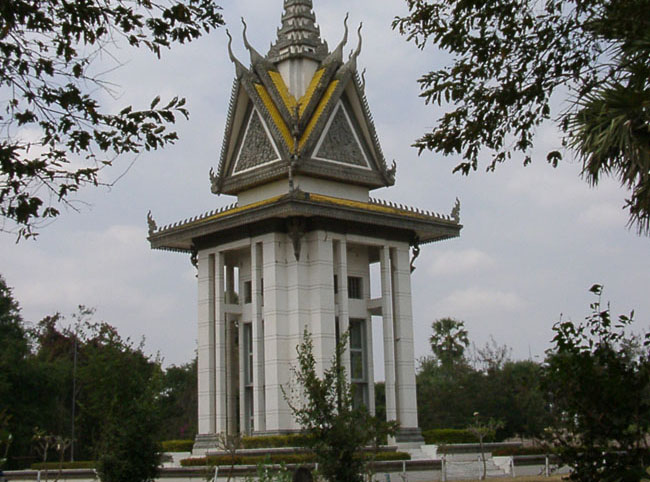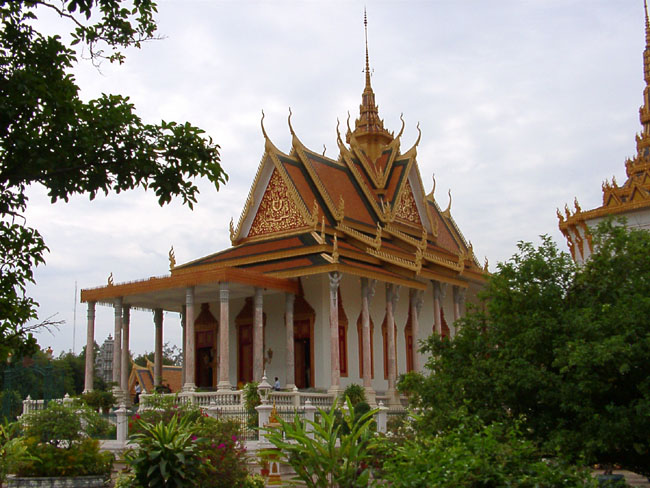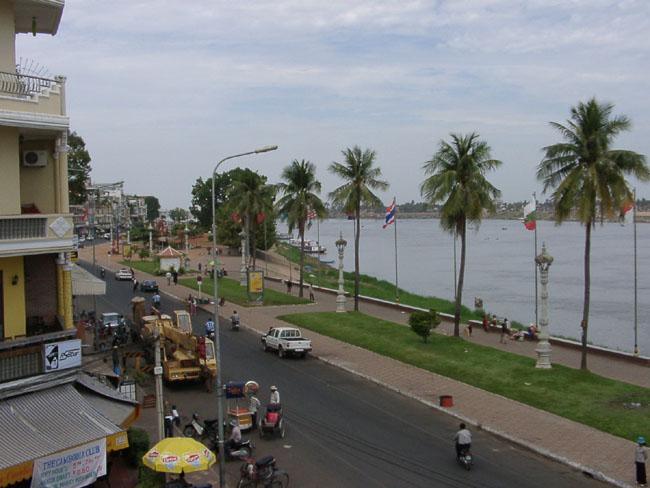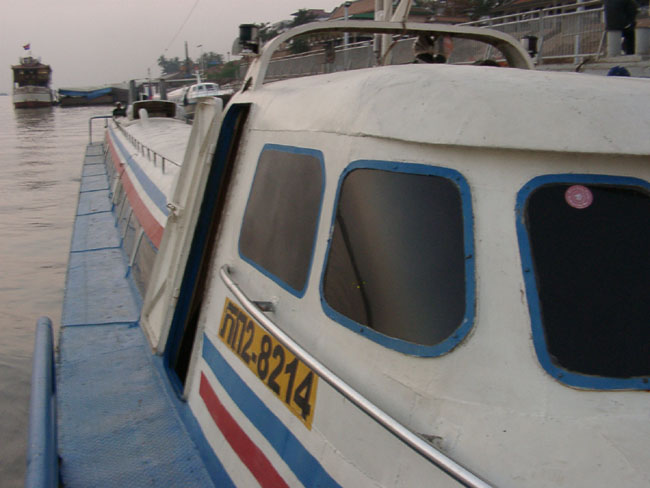| «Back to Previous Post |
Date: Thursday, 15 January 2004 16:51 PST
Subject: Greetings from the Tonle Sap River, Cambodia
Captions for photos:
1. Interrogation cell at Tuol Sleng Genocide Museum (also known as S-21).
2. Our guide in front of the photographs of some of the victims of S-21
3. The Memorial Stupa at Choeung Ek containing the skulls of 8,000 of the S-21 victims
4. The Silver Pagoda at the Royal Palace at Phnom Penh
5. City streets that border the Tonle Sap River taken from the second floor of the Foreign Correspondents Club in Phnom Penh
6. The fast boat that taxis passengers between Phnom Penh and Siem Reap
7. River life along Tonle Sap River during our trip to from Phnom Penh and Siem Reap
14 January 2004 – Day #116
We are currently on the fast boat up the Tonle Sap River from Phnom Penh to Siem Reap, Cambodia. There are about 40 people inside our boat and another 50 wind-blown souls on the roof. We have just finished staying three nights in Phnom Penh, the capital city. I have my backpack on my lap and am using it as a table for my iPAQ pocket PC and keyboard. The ride is smooth. However, the motor is noisy and the seats are crowded together like those on a discount airline.
The river is about a half a mile across at this point. Looking out the porthole next to my seat, I can see river life. There are longboats afloat next to stilted houses. I can also see fishermen, four to a boat, pulling up their nets. There are also many other kinds of watercraft from dugouts to cargo ships. The sun rose about 45 minutes ago. It is already hot and humid.
When we last wrote, we were in Chiang Mai. The next day, we carried our bags from our hotel a few blocks to the main street and flagged down a taxi for the airport. We flew from Chiang Mai in the north to Bangkok. After a short stopover, we boarded our one-hour flight to Phnom Penh.
Most of the passengers on our flight were affluent Cambodians returning with goods purchased in Thailand. Upon landing, they all went directly to passport control. We walked to the visa desk. From our guidebook and various Internet sites, we learned that three items were required for a visa: a visa application (which we picked up at the international airport in Bangkok), a passport-sized picture (which we brought from the states) and US$20 (no other currency accepted). Behind the visa desk sat six men in black uniforms and gold buttons. The process proceeded as follows:
- The first man took our passport, visa application and picture and passed it to the next man.
- The second man stapled our picture to the application and entered a “T” for tourist in the “For Official Use Only” section.
- The third man filled out the visa sticker using the information from our application and then filed the application.
- The fourth man affixed the visa on a blank page in our passport.
- The fifth man stamped the visa with two different stamps. The first one validated the visa. The second one contained his rank and name – Lt. Ly Bunna. He then filled out a receipt.
- The sixth man called our names, one by one, collected US$20 and turned over the passport with the receipt.
This whole process took less than one minute (Henry Ford would be impressed). We then stood in another line – this one was passport control. Everyone needed to stand in this line; however, by this time we arrived, most of the Cambodians were through, so the lines were short.
Here, the passport officer imaged the first page of our passport and then hand-keyed the information from the image into his computer. This took another minute. Finally, we turned in our customs card to the customs officer and entered the country.
As it was now 9pm, we had asked our hotel via email to send a taxi to pick us up. We found our driver who loaded our bags. It was weird to be in a car driving on the right hand side of the road again. In fact, since almost all of the countries on our trip were former British colonies, this was the first time we had rode on the right since we left New York – almost four months ago. As we left the airport, a large sign welcomed us to Cambodia.
We were immediately struck by the huge number of motor scooters on the streets. Later, we learned that there are about 700,000 scooters in Phnom Penh as compared to only 40,000 cars. Phnom Penh has about one million residents. Very few of the scooters carried a single person. We saw two, three and even four riders on one scooter. Almost without exception, the drivers were men. If they wore baseball caps, this meant they were “taxi” drivers. If women rode on the back, it was always sidesaddle. If there were two women on a scooter, one would ride with her feet to the left and the other to the right to ensure proper balance. Before we left Phnom Penh, we saw five riders on one scooter.
In Cambodia, as in other developing countries, the largest vehicle always has the right of way. The breakdown from largest to smallest is: Goods truck, pickup, car, auto rickshaw, motorcycle, scooter, bicycle rickshaw and bicycle. Walking makes you feel about as significant as plankton – the bottom of the food chain. Since there are few traffic lights and even fewer crosswalks, crossing the street can very dangerous. We usually hold hands and cross as a group in two stages: first to the middle and then to the other side. If you are lucky, a car is crossing at the same time, which you can use as “cover” as you cross.
The next morning, we visited two sights. The first was S-21. S-21 was formerly known as Toul Svey Prey High School. However, in 1975, it was converted by the Khmer Rouge into a prison. The current name of the building and grounds is the Tuol Sleng Genocide Museum. Here, 20,000 mostly high-ranking political prisoners were held, interrogated and tortured. Several foreigners accused of espionage were also held here. With few exceptions, the prisoners were held for between one and six months before being transferred to the “Killing Fields” in Choeung Ek for execution and burial. No one ever escaped from S-21.
In order to more-fully understand this place, we hired a guide – a young mother of two. As it turns out, our guide had lost her father, brother and sister during the rein of the Khmer Rouge from 1975-1978. Her family members did not lose their lives here at S-21. They died outside of Phnom Penh. Her father was executed because he was an officer in the Cambodian army. Her brother and sister died in the fields like so many others after being forcibly relocated by the regime. Our guide and her mother escaped death by crossing the border into Vietnam and staying there until the fall of the Khmer Rouge in early 1979.
Our guide first took us around to see the interrogation rooms and several of the second-floor detention facilities. Many of the rooms at S-21 are filled with the pictures of the victims. There are a total of 4,500 pictures – all taken by the meticulous Khmer Rouge. The remaining photos and many of the records were destroyed by the Khmer Rouge near the end of their rein. The purpose of the pictures were to aid in the capture of the prisoner should he escape.
The goal of Pol Pot and his regime was a radical restructuring of Cambodian society. During his rein of three years, he and his officers sought to eliminate all products of capitalism including clocks, automobiles and factories – even mail – in order to create an agrarian society modeled along communist lines. Even cities were considered capitalistic inventions. As a result, almost all of the inhabitants of Phnom Penh were forcibly relocated to the countryside to forced-labor farm collectives. Almost half of the country’s seven million people died during the purges, in the fields or as a result of the famine that occurred later.
The rein of the Khmer Rouge would have continued, had it not had border clashes with the Vietnamese. In the end, the Vietnamese crossed the border and disrupted the Khmer Rouge army. Those that survived headed for the hills.
After 25 years, very few of those responsible for the atrocities here have been brought to justice. In fact, Pol Pot himself lived as a free man in hiding until just four years ago when he reportedly died of a blood disease. Even more surprising is that some former Khmer Rouge members are part of the current government. To this day, there are still entire provinces, such as Battambang near the Thai border, that are more or less controlled by the Khmer Rouge. Fortunately, Phnom Penh and Siem Reap, where we are visiting, have been virtually free of incidents for the last four years.
After visited S-21, we took a taxi 12 bumpy miles out of the city center to Choeung Ek – one of the so-called ‘Killing Fields’. There, we found the mass graves of people taken from S-21 for execution and burial. In the center of the grounds, there is a chilling memorial stupa that contains 8,000 human skulls. Besides S-21 and Choeung Ek, there were approximately 167 prisons and 343 ‘Killing Fields’ with a total of 19,000 mass graves. Approximately one million people died in the prisons and the “Killing Fields” with another two million dying due to other causes such as disease or the resulting famine.
Our second day in Phnom Penh was much more pleasant. We visited the Royal Palace as well as the National Museum. The most famous building at the Royal Palace was the Silver Pagoda. Before we arrived, we learned told that the Silver Pagoda was famous for its 5,000 silver tiles. Darren mistakenly thought these tiles were roof tiles. When we arrived and he saw red ceramic roof tiles, he asked to see the map. As it turns out, the tiles mentioned are actually floor tiles. After climbing the marble steps and removing our shoes, we entered the impressive building to find that the silver tiles were covered by enormous carpets. We could hear some of the loose ones as we walked on the carpets. When no one was looking, we lifted one of the carpets to find beautiful silver tiles with pretty geometric designs. Also there was the Emerald Buddha made of Baccarat crystal and a gold Buddha containing 9,584 diamonds, some as large as 25 carats. The Khmer Rouge destroyed off about 60% of the treasures originally found here. What remains was still very impressive.
The National Museum contained mostly stone carvings “rescued” from other parts of the country, most notably from Angkor Wat in the north. In the center of the building is an atrium with a lovely garden. The centerpiece is a life-sized stone Buddha inside a small house for protection. Surrounding this structure are four ornamental pools containing koi fish and lotus water plants. After touring the museum, we relaxed there for a half an hour. We enjoyed the view and the quiet created by the walls of the museum.
It’s now two hours into our trip from Phnom Penh to Siem Reap. We still have three hours to go. We will continue to see stilted houses, coconut trees and longboats for about another hour until we reach the Tonle Sap Lake. At the point, things get pretty boring since the lake is so big, we will see little more than water.
We will stay in Siem Reap for four nights. There, we plan to visit the world-famous Angkor Wat and surrounding temples. Angkor was rediscovered by the French explorer Henri Miuhot in 1860’s. Since that time, Angkor Wat has become a major tourist attraction, bringing with it needed hard currency. There are also temples in the surrounding area, some which were previously covered up by the jungle. The architecture and landscaping of the Indiana Jones ride at Disneyland seems to be at least partially inspired by these ruins.
God’s Blessings,
Darren and Sandy
| «Back to Previous Post |

